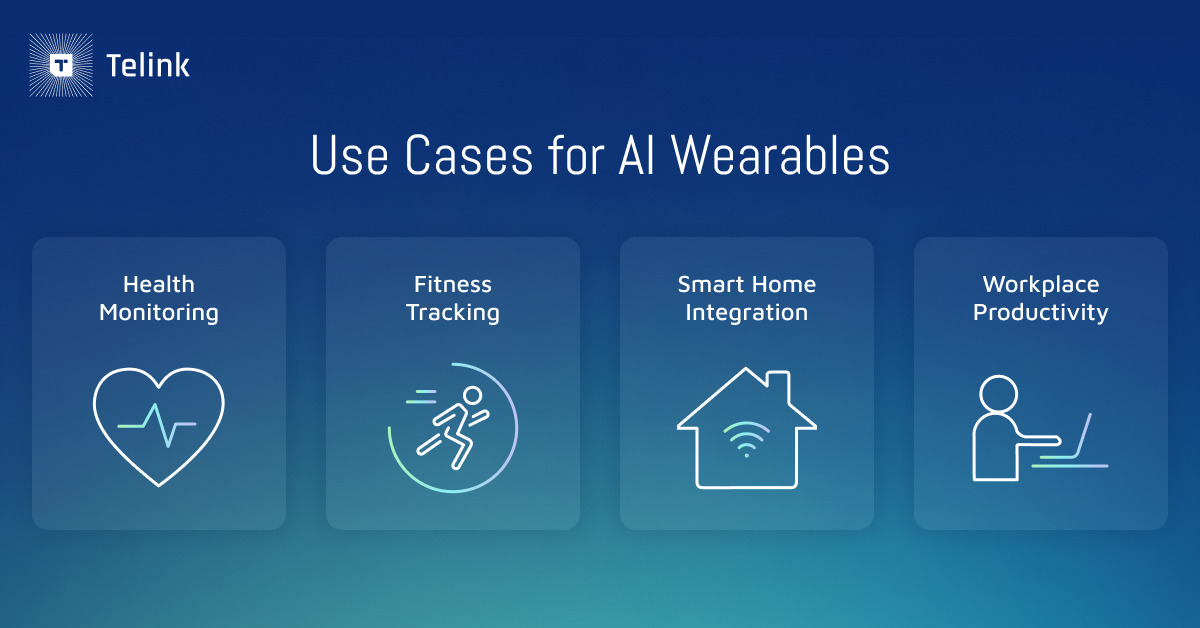



PLEASE ROTATE ME


Telink Staff
September 13, 2024

As AI gains traction, wearables are in need of a smarter upgrade.
Artificial intelligence (AI) is dominating many sectors of the IoT industry as leaders in healthcare, transportation, logistics, corporate, and more look to integrate smarter solutions to streamline everyday operations. This places additional pressure on product developers to push the boundaries of innovation and keep up with the pace of evolving technology. One application that offers immense potential? Wearables.
Combining AI with wearable technology grants developers the opportunity to enhance existing functionalities, improve user experiences, and open new avenues for data-driven insights. For example, patients using wearables for remote health monitoring can receive granular data and real-time analyses of their information for more accurate and timely health intervention. Or, fitness gurus can receive recommended workout routines based on previous workouts recorded on fitness trackers to optimize their regimen.
As consumers look to wearables to add convenience and a degree of connectivity to their lives, now is the time for product developers to brainstorm unique ways to embed AI capabilities into wearables and reimagine mobile technology as we know it.
AI uses natural language processing and machine learning (ML) to enable wearables to go beyond basic functions and recognize patterns in user behavior, anticipate future needs, and provide real-time responses.
The current market includes a variety of wearables—fitness trackers, smartwatches, and biometric rings—that monitor health metrics like one’s respiratory rate, sleep patterns, and cardiac activity. Though these devices have transformed personal health management, they often fall short in assisting real-time decisions, offering proactive recommendations, and, ultimately, helping users make sense of their data. This is where AI truly shines, transforming wearables from simple data collectors to intelligent, proactive tools.

From healthcare to corporate offices, here are ways AI wearables can benefit users—and applications product developers can build upon:
Today’s wearables allow for continuous, real-time monitoring of vital signs, but with AI, these devices can analyze recorded data to detect abnormalities, sending alerts to users or even healthcare professionals when early signs of health issues appear. In this way, wearables used for healthcare purposes can switch from a reactive tool to a proactive one, assisting both patients and healthcare providers with preventive care.
Fitness trackers equipped with AI capabilities can offer personalized workout plans, real-time coaching, and motivational feedback based on a user’s unique data and activity history. Instead of relying on static metrics, AI models can predict user fatigue levels, recommend optimal recovery times, and create dynamic fitness goals tailored to each individual’s progress and behavior, making workouts more productive and effective.
With AI, users don’t need to rely on their smartphones to control their smart home environments. Wearables integrated with AI can join these connected ecosystems, granting users control over lighting, temperature, security systems, and more. For example, a simple gesture or voice command can trigger a series of smart actions, providing a seamless, intuitive experience. AI’s ability to learn user preferences over time also allows for more personalized smart home automation, making these environments feel more like home without user intervention.
Companies can also leverage AI wearables to check in on their employees’ well-being. By tracking stress levels, posture, and physical exertion, wearables can provide data-driven insights that enhance ergonomics, prevent burnout, and improve overall productivity. As a result, business leaders can use these insights to adjust work environments and optimize employee performance to maximize output.
While AI-powered wearables bring undeniable benefits, developers still have to tackle a few key challenges from concept to creation:
Every wearable comes with its own unique set of functions and features, but if you’re planning on using AI to upgrade your device, following these general steps can keep your project on the right track:
1. Identify Objectives: Clearly define the purpose of integrating AI into your device. Understanding user needs will also help you determine the best AI solutions to implement, as not all capabilities will be relevant to your specific use case.
2. Figure Out Data Collection and Management: AI is only as effective as the data it processes. Develop strategies for collecting high-quality, relevant data from wearables, and remember to ensure that the data remains accurate and consistent while maintaining user privacy.
3. Choose the Right AI Model: Select AI models that align with your objectives, whether they involve predictive analytics, anomaly detection, or personalized recommendations. Focus on model training and validation to improve accuracy and adaptability over time.
4. Develop the Integration Architecture: Design an architecture that seamlessly integrates AI with IoT. Scalability and flexibility should be at the forefront of the design to allow for future updates and advancements.
5. Implement AI Algorithms: Embedding AI algorithms into wearable devices requires balancing performance with resource constraints. You want to ensure an ideal balance between your wearable’s hardware limitations and AI’s capacities to avoid performance bottlenecks down the line. Above all, try to focus on real-time data processing, ensuring that the AI model you choose can make immediate decisions based on user input and sensor data.
6. Prioritize User Interface and Experience: AI should enhance, not complicate, the user experience. Design intuitive user interfaces that allow users to easily access AI-driven insights. You can conduct regular feedback during development to refine your device to align more with user preferences.
7. Adapt Accordingly: AI and IoT technologies are constantly evolving, so your device should too. Iterative development, where models are tested and refined regularly, is crucial to keeping your product up-to-date with the latest technological advancements and relevant to users for years to come.
Whether implemented on the high-performance general purpose processor embedded in our SoC or through a standalone AI processor, we have the solutions you need to make your creative development project a reality. Plus, we collaborate with ecosystem partners to provide support throughout your entire development cycle for a seamless process and faster time-to-market.
Visit Telink’s wiki to learn more about our development resources, or contact us directly today.